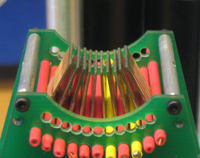Virtual Braille
Investigators
Vincent Levesque, Jerome Pasquero and Vincent HaywardIntroduction
Our earlier work on virtual braille by lateral skin deformation was limited to the display of a sequence of braille dots because of the single-row tactile transducer used. Sustained efforts have since resulted in the , a 2D tactile display with a matrix of 10 by 6 actuators. Although not designed for braille, this display makes it possible to produce multiple rows of virtual dots. We therefore experimented with the laterotactile display of complete braille cells by mounting the on a slider and extending our previous tactile rendering algorithms.
 |
 |
| (a) | (b) |
| Figure 1: Experimental apparatus: (a) tactile display mounted on a slider, and (b) picture of the tactile display. | |
Dot Rendering
Our prior work demonstrated that a sensation similar to that of brushing against a braille dot could be obtained by propagating a compression and expansion pattern on the skin in response to finger movement (Fig. 2a). It also showed that adding a textural component by gently oscillating the actuators over a dot could increase contrast and facilitate reading (Fig. 2b). Our initial experimentation with the also indicated that using texture alone in place of a dot could be desirable (Fig. 2c). The activation patterns resulting in those three sensations are shown for a single row of actuators in the following figure.
 texture=0% |
 |
 texture=25% |
 |
 texture=100% |
 |
| Figure 2: Rendering of a single Braille dot with three levels of texture. | |
Cell Rendering
We developed and informally evaluated four methods of producing three rows of dots from the 's six rows of actuators. The first method paired rows of actuators for maximum skin deformation. The second added shearing within pairs of actuator rows. Unfortunately, these two methods were felt as 6 rows of dots and had to be rejected. The third method used a single row of actuators per row of dots, producing an acceptable sensation. The fourth method attempted to increase the separation between adjacent dots by shifting dots on the second column of a braille cell to lower actuators rows. It was felt as misaligned braille and therefore the third method was selected for further experimentation. The following figure illustrates the activation pattern corresponding to these four rendering methods.
 |
 |
 |
 |
 |
 |
 |
 |
| Figure 3: Four approaches to the rendering of a complete Braille cell with six rows of actuators. | |||
Activation Patterns
The following movies show the actuator activation patterns produced by displacement of the display at constant speed over a virtual braille cell. Note that the display would normally move from left to right rather than be fixed as shown. The pattern is shown on an 8x8 variant of the .
| (a) | (b) |
| Figure 4: Example of braille rendering on an 8x8 tactile display: (a) four cell rendering methods, and (b) three texture levels. | |